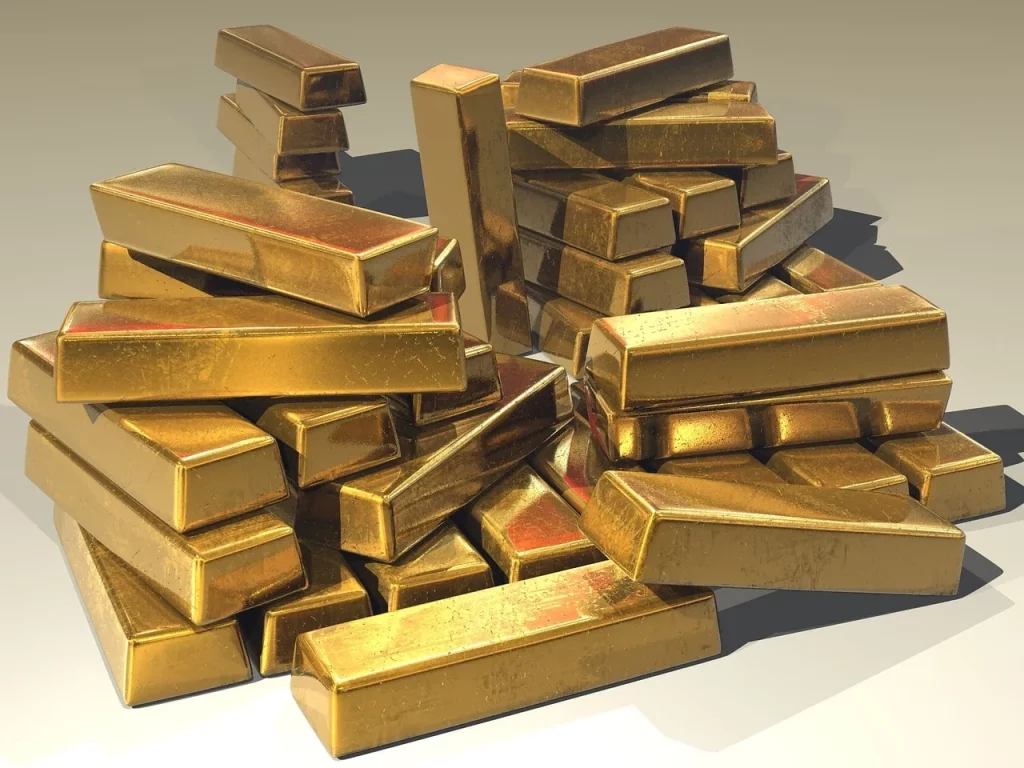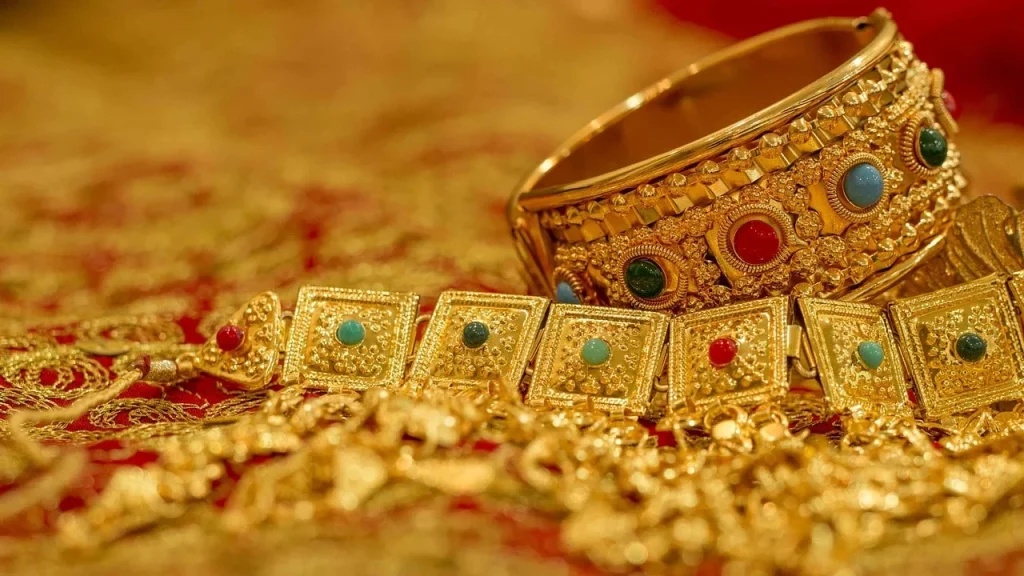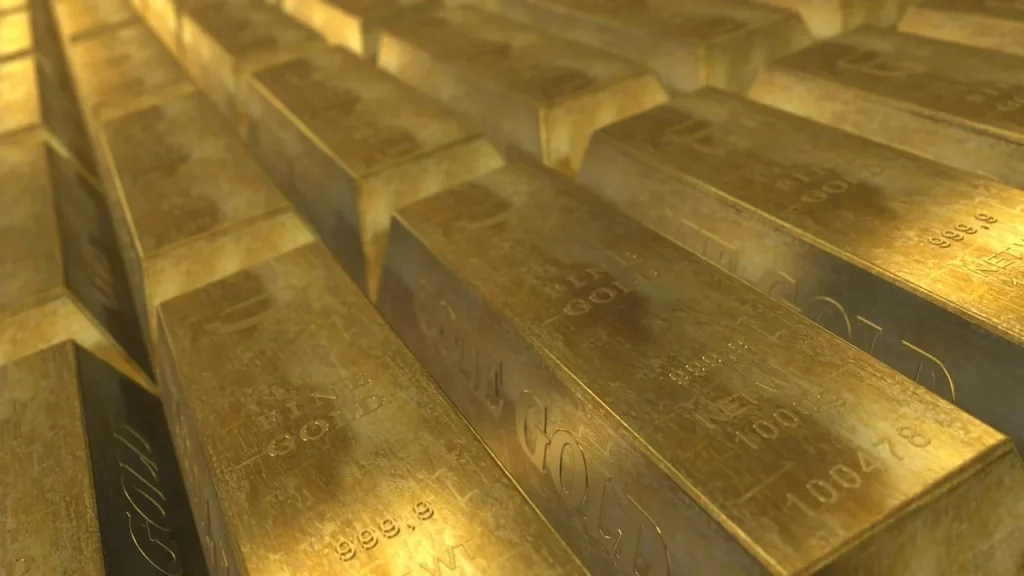We live in a world where one element can dictate the rise and fall of empires, inspire countless quests and adventures, and still be a cornerstone in technology today. That element is gold, a metal that has captured our imaginations and desires like no other.
As we explore some interesting gold facts, we’ll uncover stories of opulence, greed, innovation, and artistry. From its atomic structure to its pivotal role in global economies, prepare to be dazzled by the myriad ways gold has shaped our past, enriched our present, and may even determine our future. Are you ready to see the world through golden-tinted glasses?
Gold is money. Everything else is credit.
J.P. Morgan
Gold Facts
Dive into the world of gold, a symbol of wealth and beauty through the ages. Keep your eyes open for the details, because at the end of this article, I created a quiz to test your expertise. Will you shine as a true gold nerd?
- The vast oceans on our planet hold approximately 20 million tons of gold dispersed at a minute concentration of about 0.04 micrograms in every liter of seawater.
- Consumable gold is a reality; it’s frequently used to embellish luxury foods and beverages, adding a touch of opulence.
- An ounce of gold can be expanded into a sheet nearly 100 square feet in size or drawn into a wire 50 miles long, showcasing its incredible malleability.
- The heaviest gold bar globally weighs 250 kg (551 lb), crafted by Mitsubishi Materials Corporation in Japan, showcasing the extremes of gold accumulation.
- Gold’s ductility allows it to be fashioned into thread for sewing, with an ounce stretching over 50 miles, highlighting its exceptional pliability.
- Jewelry is the primary application for gold, absorbing about 78% of the annual gold output.
- Since the 16th century, European cuisine has utilized gold leaf to garnish foods and beverages, adding a luxurious flair.
- All the gold ever mined would fit into a cube with sides measuring only 22 meters, emphasizing gold’s rarity and value.
- Gold on our planet primarily originated from meteorites that bombarded Earth over 200 million years after its formation.
- The United States Bullion Depository, famously known as Fort Knox, holds the world’s most significant official gold reserve.
- Due to its chemical inertness, gold remains untarnished by air, water, or soil, maintaining its lustrous appearance indefinitely.
- The Latin word ‘aurum’, meaning ‘glowing dawn’, is the origin of gold’s element symbol, Au.
- Traditionally, India consumes the most gold worldwide, especially in the form of jewelry.

- The electronics industry highly values gold for its excellent electrical conductivity and resistance to corrosion.
- Olympic gold medals must contain at least 92.5% silver and be coated with a minimum of 6 grams of pure gold.
- In the medical field, gold is used for surgical repairs of blood vessels, nerves, bones, and membranes.
- Researchers are exploring gold nanoparticles as a potential treatment for cancer, aiming to precisely target and eliminate tumor cells.
- The global oceans are believed to contain up to 15,000 tons of gold, hidden within their vast expanses.
- South Africa has been a leading source of the world’s gold, contributing two-thirds of the global supply.
- Every continent on Earth has reported discoveries of gold, attesting to its widespread distribution.
- The creation of the first gold coins took place in Lydia (now part of modern Turkey) around 600 BC.
- Gold’s enduring nature is due to it being one of the least reactive elements, which prevents corrosion and tarnish.
- The melting point of gold is 1,064°C (1,947°F), making it relatively easy to melt compared to other metals.
- Discovered in Bulgaria, the Varna Necropolis is deemed the world’s oldest gold treasure, dating back more than 6,000 years.
- Gold leaf’s thickness can be reduced to 1/8000th of a millimeter, so thin that it becomes semi-transparent.
- The 19th-century gold rushes in locations like California and Australia are famous for prompting massive migrations in search of gold.
- Despite gold’s abundance in the Earth’s crust, its rarity is due to its sparse distribution.
- Quartz veins in the oldest parts of the Earth’s crust are common sites for finding gold.

- Recycling contributes to around one-third of the gold supply in the market, highlighting the importance of repurposing existing gold.
- The International Monetary Fund (IMF) and central banks have significant influence over the gold market.
- Alloying gold with other metals can result in a spectrum of colors, from silver-white to green and orange, showcasing gold’s versatility.
- Pyrite, known as “fool’s gold,” is often mistaken for real gold because of its metallic luster and brassy color.
- Pure gold is defined as 24 carats, serving as a benchmark for purity in gold products.
- The hardness of gold alloys is measured using the Vickers scale, where pure gold is soft but hardens when mixed with other metals.
- The Witwatersrand Basin in South Africa is recognized for being the most extensive gold resource on the planet.
- Gold was crucial in the electrical wiring of the Lunar Module, illustrating its importance in space exploration.
- A “gold standard” monetary system directly links a country’s currency value to its gold reserves.
- Gold dermatitis is an allergic reaction some people experience when exposed to gold, illustrating its biocompatibility limits.

- The “Welcome Stranger” is the name of the largest gold nugget ever found, weighing over 70 kilograms (150 pounds) and discovered in Australia in 1869.
- Gold’s use in dental restorations is due to its durability, biocompatibility, and aesthetic appeal.
- For treating rheumatoid arthritis, gold salts are utilized for their anti-inflammatory properties, showcasing gold’s medicinal value.
- Gold mining’s environmental impact includes deforestation, soil erosion, and water contamination, highlighting the ecological costs of gold extraction.
- Bacteria capable of converting toxic ions into gold nuggets through microbial alchemy are being studied for potential mining applications.
- Throughout history, gold’s value has served as a standard for pricing goods and services, demonstrating its enduring economic significance.
- The excitement and obsession with finding gold, known as “gold fever,” have driven individuals and societies to great lengths in pursuit of wealth.
- Since ancient times, gold leaf has been used to decorate manuscripts and art, adding a touch of luxury to cultural artifacts.
- Gold suspended in liquid, known as colloidal gold, is utilized in medical and biological research for its unique properties.
- The practice of hallmarking gold items was developed to certify their purity, ensuring trust in gold transactions.
- The allure of gold has made it a target for theft and looting throughout history, underscoring its value and desirability.
- Gold’s atomic number is 79, placing it among the higher atomic number elements that occur naturally. This atomic structure gives gold its unique chemical and physical properties, including its incomparable luster and resistance to tarnish.
Gold Myths

After exploring all these fun facts about gold, it’s time to delve deeper and separate the truth from the myth. Let’s uncover what’s real and what’s simply a tale.
- Gold Does Not Tarnish
Gold is often believed to be an indestructible metal that does not tarnish. However, while pure gold is highly resistant to tarnish, lower karat gold, which is alloyed with other metals, can tarnish when exposed to harsh conditions due to the presence of these other metals. - The Larger the Gold Nugget, the Purer It Is
It’s a common misconception that the size of a gold nugget is directly related to its purity. In reality, the purity of gold nuggets varies greatly, regardless of their size. Purity is determined by the amount of other metals mixed with the gold, not its size. - All Gold Is Mined from Underground
While much of the world’s gold is mined from underground deposits, not all of it comes from deep within the earth. It can also be mined from surface deposits, riverbeds, and placer deposits through various mining methods, including open-pit mining and panning. - Gold Is the Most Expensive Metal
Gold is often thought to be the most expensive metal due to its popularity and use in jewelry and investments. However, there are several metals, such as rhodium, palladium, and platinum, that are rarer and can command higher prices than gold. - Gold Is Only Used for Jewelry and Currency
Although it is widely recognized for its use in jewelry and as a form of currency, its applications extend far beyond these areas. Gold is crucial in electronics, dentistry, and aerospace for its excellent conductivity, non-reactivity, and resistance to corrosion.
No products found.
Gold Quotes

We continue with some of my favorite quotes about gold. You can share yours in the comments as well, so I can add them to the list.
Gold has two significant shortcomings, being neither of much use nor procreative.
Warren Buffett
Warren Buffett, one of the world’s most successful investors, criticizes gold for its lack of utility and inability to generate income, highlighting his preference for more productive assets.
Gold is a way of going long on fear.
John Paulson
John Paulson, a hedge fund manager known for his profitable bet against the U.S. housing market, sees gold as an investment that benefits from global uncertainties and fear.
Whoever has the gold makes the rules.
Unknown, but often attributed to the Golden Rule
This adage, often linked to the Golden Rule, suggests that wealth, particularly in the form of gold, grants power and influence over others, encapsulating the might of financial leverage.
Gold is the corpse of value.
Neal Stephenson
Neal Stephenson, a renowned science fiction and speculative fiction author, offers a provocative view of gold, suggesting that while it may hold value, it is inert, lacking the vitality of active investments or creative endeavors.
Gold is the treasure, and he who possesses it does all he wishes to in this world and succeeds in helping souls into paradise.
Christopher Columbus
Christopher Columbus, the famous explorer, reflects on the transformative power of gold, not just as material wealth but as a means to achieve worldly desires and spiritual aspirations.
Gold FAQ

As we transition from the insightful quotes about gold, we approach the final section before our trivia. Pay close attention to the upcoming FAQs to ensure your success in the quiz.
- Will gold stick to a magnet?
No, gold will not stick to a magnet. Gold is a non-magnetic metal, which means it doesn’t have magnetic properties under normal circumstances. However, if the gold you have is mixed with iron or other magnetic metals, it might show some attraction to a magnet. - How is gold formed?
Gold is believed to be formed in the universe through a process called the nucleosynthesis of heavy elements, which occurs during explosive events such as supernovae and the collision of neutron stars. Gold then travels through space, eventually becoming part of planets, including Earth, where we find it today in the crust and mantle, concentrated by geological processes over billions of years. - Can gold rust?
Gold cannot rust. Rusting is a process that specifically involves iron or iron alloys oxidizing due to exposure to oxygen and moisture, resulting in iron oxide (rust). Gold, however, is one of the least reactive chemical elements and does not oxidize in air or water. This inertness is one of the reasons gold is so valued, especially for use in jewelry and as a long-term store of value. - Where can gold be found?
It can be found in several places around the world, primarily in rock formations and riverbeds. It’s mined from lode deposits within the rock, where it’s found as free gold separated from other materials, or as placer deposits in riverbeds, where the action of water has separated and concentrated the gold from other materials. Countries with significant gold mining operations include South Africa, China, Australia, Russia, and the United States, among others. - Why is gold value going up?
The value of gold tends to go up for several reasons, often related to its status as a “safe haven” asset. During times of economic uncertainty, inflation, or geopolitical tensions, investors may flock to gold as a store of value and a hedge against currency devaluation or stock market volatility. Other factors influencing the price include changes in supply and demand, central bank policies, interest rates, and the health of the global economy.
No products found.
Gold Quiz

Welcome to the Gold Quiz, where the stakes are as high as Fort Knox’s security. Fail to strike gold, and you might just find yourself turning into a walking, talking gold bar. Let’s see if you can shine or if you’ll end up as part of someone’s jewelry collection!
Conclusion
In the end, gold’s allure goes beyond its glittering facade. It’s a metal that has captivated human imagination for millennia, embodying wealth, power, and beauty. But it’s also a symbol of human ingenuity, from the ancient alchemists’ dreams of transmuting base metals into gold to modern engineers harnessing its conductive properties in cutting-edge technologies.
Gold’s journey through history is a testament to its timeless value and our unending quest for that which glimmers. So, as we wrap up our golden exploration, let’s remember that this precious metal is more than just a commodity; it’s a chapter in the human story, woven with dreams, battles, and innovation.
Let’s close this journey with a funny question: If you could turn anything into gold with a touch, what would be the first thing you’d transform, and why? Let me know in the comments.
2 Sources Used For This Article


2 Comments
After Dark Souls this is the second place I saw the word “Tarnish” so much.
Hahaha may the erdtree guide you.